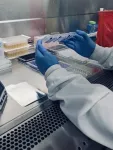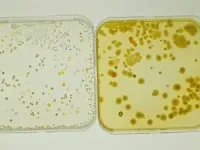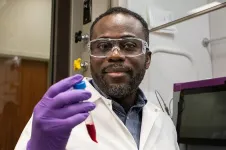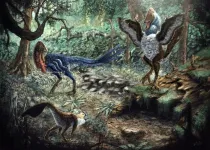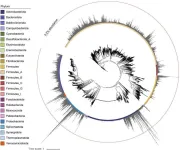(Press-News.org) UNIVERSITY PARK, Pa. — An estimated 1,600 people in the U.S. contract a serious infection from Listeria bacteria in food each year and, of those individuals, about 260 people die, according to the Centers for Disease Control and Prevention. Penn State researchers may now better understand how the bacteria, called Listeria monocytogenes, survive and persist in fruit-packing plants by evading and surviving sanitizers.
According to their study, which is now available online and will be published in the June issue of the journal Biofilm, biofilms — comprising otherwise harmless microorganisms that attach to each other and the food surface — result in a kind of shield that surrounds and protects the Listeria. The findings may result in changes to sanitation protocols in food-processing facilities that promise to diminish contamination of food with Listeria, the researchers said.
“We found two groups of microorganisms in the tree fruit packing environments, Pseudomonadaceae and Xanthomonadaceae, that are very good at forming biofilms and protecting Listeria monocytogenes,” said corresponding author Jasna Kovac, the Lester Earl and Veronica Casida Career Development Professor of Food Safety. “Biofilms represent a physical barrier that reduces the effective diffusion and antimicrobial action of sanitizers and is hypothesized to increase L. monocytogenes’ tolerance to sanitizers used in food processing facilities.”
As a result of the biofilms shielding the pathogen, the sanitizers are not as effective in killing Listeria monocytogenes, explained Laura Rolon, who recently earned her doctorate from Penn State and spearheaded the study.
“Our research suggests that if packing facilities are having a recurring problem with Listeria monocytogenes, they may need to assess whether biofilm-forming microorganisms are causing it,” she said.
This study’s results indicate a need to assess the efficacy of commonly used sanitizers against non-pathogenic biofilm-forming microorganisms commonly found in the food processing environments to prevent biofilms from establishing, Kovac explained. The results of further assessments could help inform practical recommendations for the industry, such as application concentrations and times, to prevent biofilm formation and improve the control of Listeria monocytogenes in these environments.
In future workshops and short courses, Penn State Extension educators will communicate the research findings to professional organizations dedicated to sanitation in food-processing facilities, noted study co-author Luke LaBorde, professor of food science and extension specialist.
“The findings of this research project will inform and enhance sanitation protocols and extension training efforts targeted at the tree-fruit industry to effectively control L. monocytogenes,” said LaBorde, an expert in the tracking of Listeria monocytogenes in produce production and processing environments. The bridge between scientific discovery and dissemination among stakeholders, he added, is a vital part of this work and a prime example of the mission of a land-grant university like Penn State.
To that end, Penn State Extension routinely offers workshops and other resources to communicate research findings, such as the Listeria monocytogenes-biofilms study results, and promote other best practices for controlling foodborne pathogens. These trainings are typically attended by food-processing plant professionals, representatives of industry associations, food safety consultants and government inspectors.
Partially because of their research on Listeria monocytogenes and biofilms, Kovac and LaBorde won the Integrated Team Award from the College of Agricultural Sciences late last year.
Other co-authors include M. Laura Rolan, Olena Voloshchuk and Katelyn V. Bartlett, all with the Department of Food Science in the College of Agricultural Sciences at Penn State.
The U.S. Department of Agriculture supported this research.
END
Foodborne-pathogen Listeria may hide from sanitizers in biofilms
The finding could result in more effective sanitation procedures, leading to safer food supply, researchers said
2024-01-24
ELSE PRESS RELEASES FROM THIS DATE:
Purdue Innovates awards Purdue researchers $150K to develop innovations for the marketplace
2024-01-24
WEST LAFAYETTE, Ind. – Four researchers in Purdue University’s colleges of Engineering and Science, the Purdue Institute for Cancer Research and the Purdue Institute for Drug Discovery have received a total of $150,000 from the Trask Innovation Fund to strengthen the appeal of their patent-pending intellectual property for commercial use.
The fund is managed by the Purdue Innovates Incubator, which provides programming for the Purdue University community to ideate, refine and support their solutions. The fund awards up to $50,000 for short-term projects that enhance the commercial value of Purdue intellectual ...
JMIR Bioinformatics and Biotechnology invites submissions for research papers on machine learning-driven genomic predictive models
2024-01-24
JMIR Publications is pleased to announce a new theme issue titled “Machine Learning-Based Predictive Models Using Genomic Data” in JMIR Bioinformatics and Biotechnology. The peer-reviewed journal is indexed in SCOPUS and focused on research in bioinformatics, computational biology, and biotechnology. This new theme issue aims to explore cutting-edge research at the intersection of machine learning and genomics, fostering advancements in predictive modeling for biological insights.
JMIR Bioinformatics and Biotechnology welcomes contributions from global researchers, educators, and practitioners. We encourage submissions exploring diverse aspects of bioinformatics ...
Humpback whales move daytime singing offshore, research reveals
2024-01-24
Humpback whale singing dominates the marine soundscape during winter months off Maui. However, despite decades of research, many questions regarding humpback whale behavior and song remain unanswered. New research revealed a daily pattern wherein whales move their singing away from shore throughout the day and return to the nearshore in the evening. The findings were led by the University of Hawaiʻi, in partnership with NOAA’s Hawaiian Islands Humpback Whale National Marine Sanctuary, and published in Royal Society Open Science.
“Singers may be attempting to reduce the chances of their song being drowned ...
New oviraptor dinosaur from the US Hell Creek Formation lived at the end of the Age of Dinosaurs and weighed about the same as an average woman
2024-01-24
New oviraptor dinosaur from the US Hell Creek Formation lived at the end of the Age of Dinosaurs and weighed about the same as an average woman
###
Article URL: https://journals.plos.org/plosone/article?id=10.1371/journal.pone.0294901
Article Title: A new oviraptorosaur (Dinosauria: Theropoda) from the end-Maastrichtian Hell Creek Formation of North America
Author Countries: USA, Canada
Funding: Funding for histology processing provided to HNW by Oklahoma State University for Health Sciences. Funding to GFF provided by the Royal Society (Grant NIF\R1\191527) and a Banting Fellowship ...
Galápagos penguin is exposed to and may accumulate microplastics at high rate within its food web, modelling suggests
2024-01-24
Modelling shows how microplastics may bioaccumulate in the Galápagos Islands food web, with Galápagos penguins most affected, according to a study published January 24, 2024 in the open-access journal PLOS ONE by Karly McMullen from the University of British Columbia, Canada, under the supervision of Dr. Juan José Alava and Dr. Evgeny A. Pakhomov of the Institute for the Ocean and Fisheries, University of British Columbia, Canada, and colleagues.
We know that microplastics are building up in our oceans, but the extent of the damage to marine organisms is still being assessed. Here, McMullen and colleagues focused ...
Obesity spiked in children during COVID-19 lockdowns—only the youngest bounced back
2024-01-24
Obesity among primary school children in the UK spiked during the COVID-19 lockdown, with a 45% increase between 2019/20 and 2020/21 among 4-5-year-olds, according to a study published on January 24, 2024 in the open-access journal PLOS ONE by Iván Ochoa-Moreno from the University of Southampton, UK, and colleagues. The authors estimated that without reversals, increased obesity rates in Year 6 children alone will cost society an additional £800 million in healthcare.
During the first year of the pandemic, school closures dramatically altered the routines of young children. Cancellation of organized sports, ...
Risk of death during heatwaves in Brazil linked to socioeconomic factors
2024-01-24
A new study suggests that heatwaves are exacerbating socioeconomic inequalities in Brazil, with people who are female, elderly, Black, Brown, or who have lower educational levels potentially facing greater risk of death during heatwaves. Djacinto Monteiro dos Santos of Universidade Federal do Rio de Janeiro, Brazil, and colleagues present these findings in the open-access journal PLOS ONE on January 24, 2024.
As climate change progresses, heatwaves are becoming hotter, longer, and more frequent in many regions ...
DNA from preserved feces reveals ancient Japanese gut environment
2024-01-24
DNA from ancient feces can offer archaeologists new clues about the life and health of Japanese people who lived thousands of years ago, according to a study published January 24, 2024 in the open-access journal PLOS ONE by Luca Nishimura and Ituro Inoue from the National Institute of Genetics, Japan, Hiroki Oota from The University of Tokyo, Mayumi Ajimoto from Wakasa History Museum, and colleagues.
Fossilized feces, also known as coprolites, can preserve an array of genetic material from the digestive tracts ...
A virus that infected the first animals hundreds of millions of years ago has become essential for the development of the embryo
2024-01-24
At least 8% of the human genome is genetic material from viruses. It was considered ‘junk DNA’ until recently, but its role in human development is now known to be essential
Researchers at the Spanish National Cancer Research Centre (CNIO) describe for the first time the role of these viruses in a key process in development, when cells become pluripotent few hours after fertilization
The finding, published in Science Advances, is relevant for regenerative medicine and for the creation of artificial ...
City of Hope, TGen researchers develop machine-learning tool to detect cancer earlier via liquid biopsy
2024-01-24
LOS ANGELES — Researchers at City of Hope, one of the largest cancer research and treatment organizations in the United States, and Translational Genomics Research Institute (TGen), a precision medicine research organization that is part of City of Hope, have developed and tested an innovative machine-learning approach that could one day enable the earlier detection of cancer in patients by using smaller blood draws. The study was published today in the journal Science Translational Medicine.
“A huge body of evidence shows that cancer caught at later stages kills people. This new technology gets us closer to a world ...
LAST 30 PRESS RELEASES:
Researchers develop AI Tool to identify undiagnosed Alzheimer's cases while reducing disparities
Seaweed based carbon catalyst offers metal free solution for removing antibiotics from water
Simple organic additive supercharges UV treatment of “forever chemical” PFOA
£13m NHS bill for ‘mismanagement’ of menstrual bleeds
The Lancet Psychiatry: Slow tapering plus therapy most effective strategy for stopping antidepressants, finds major meta-analysis
Body image issues in adolescence linked to depression in adulthood
Child sexual exploitation and abuse online surges amid rapid tech change; new tool for preventing abuse unveiled for path forward
Dragon-slaying saints performed green-fingered medieval miracles, new study reveals
New research identifies shared genetic factors between addiction and educational attainment
Epilepsy can lead to earlier deaths in people with intellectual disabilities, study shows
Global study suggests the underlying problems of ECT patients are often ignored
Mapping ‘dark’ regions of the genome illuminates how cells respond to their environment
ECOG-ACRIN and Caris Life Sciences unveil first findings from a multi-year collaboration to advance AI-powered multimodal tools for breast cancer recurrence risk stratification
Satellite data helps UNM researchers map massive rupture of 2025 Myanmar earthquake
Twisting Spins: Florida State University researchers explore chemical boundaries to create new magnetic material
Mayo Clinic researchers find new hope for toughest myeloma through off-the-shelf immunotherapy
Cell-free DNA Could Detect Adverse Events from Immunotherapy
American College of Cardiology announces Fuster Prevention Forum
AAN issues new guideline for the management of functional seizures
Could GLP-1 drugs affect risk of epilepsy for people with diabetes?
New circoviruses discovered in pilot whales and orcas from the North Atlantic
Study finds increase in risk of binge drinking among 12th graders who use 2 or more cannabis products
New paper-based technology could transform cancer drug testing
Opioids: clarifying the concept of safe supply to save lives
New species of tiny pumpkin toadlet discovered in Brazil highlights need for conservation in the mountain forests of Serra do Quiriri
Reciprocity matters--people were more supportive of climate policies in their country if they believed other countries were making significant efforts themselves
Stanford Medicine study shows why mRNA-based COVID-19 vaccines can cause myocarditis
Biobanking opens new windows into human evolution
Sky-high smoke
AI tips off scientists to new drug target to fight, treat mpox
[Press-News.org] Foodborne-pathogen Listeria may hide from sanitizers in biofilmsThe finding could result in more effective sanitation procedures, leading to safer food supply, researchers said
